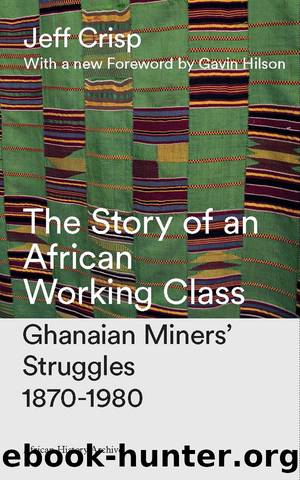The Story of an African Working Class by Jeff Crisp

Author:Jeff Crisp [Crisp, Jeff]
Language: eng
Format: epub
Tags: Nonfiction, Social & Cultural Studies, Political Science, Social Science, History
ISBN: 9781783609734
Publisher: Bloomsbury Publishing
Published: 2017-02-15T05:00:00+00:00
Tensions within the MEU
The 1947 strike and Gorman Award immediately boosted the popularity of the MEU. Prior to the strike only 2,050 workers, 5.6 per cent of the labour force, were paid-up union members. By 1947-48 this figure had jumped to 15,000 (39.9 per cent) and by 1948-49 to 15,500 (42.2 per cent). Although half the mine workers remained outside the union, the Government admitted that the MEU had âan influence which extends beyond that of its membershipâ.13 Encouraged by the unionâs new popularity, Sam and Bissah made no radical changes to MEU policy after 1947. The strike weapon was still regarded as a last resort, and the leadership acknowledged that âsince our cry is for better pay we must also put out our best and spend our energy to increase productionâ.14 Sam and Bissah continued to avoid political affiliations, and were congratulated by the Labour Department for their âexemplary behaviourâ and âconsistent and responsible policyâ during the civil disturbances of February 1948.15 This moderate, productionist and apolitical policy was to come under attack from three sources between 1947 and 1950: from rank-and-file workers who wanted to use the strike weapon more freely than the union leadership; from workers and branch union officials who wanted the MEU to play a more active role in the nationalist movement; and from politicians who also sought to enlist the unionâs support in the quest for self-government.
The problem of rank-and-file autonomy within the MEU became clear almost immediately after the implementation of the Gorman Award. In January 1948 underground workers went on strike at the Central Wassau Mine over a mistake in the calculation of back pay, and walked around the mine armed with sticks ignoring the branch unionâs advice to work normally. The following month 400 workers at Amalgamated Banket Areas (ABA) went on strike to demand the dismissal of the Mine Doctor. The Mine Manager reported that there existed âa certain group of people against the union, and in ABA is losing groundâ. Similarly, at AGC the Mine Manager observed that the branch union was ânot nearly so strong as it wasâ.16
The most dramatic manifestation of rank-and-file independence occurred not at a gold mine but at the Nsuta manganese mine, where two unofficial strikes took place in January and February 1948. The first strike, which was about the dismissal of a shovel driver for inefficiency, was organized by a group of workers calling themselves âThe New Order of Youngbloodsâ. Sam and Bissah condemned the strike but failed to convince the workers to ignore the breakaway organization. The second strike followed the branch unionâs decision to support managerial warnings issued to two masons accused of unsatisfactory work. The New Order persuaded 1,000 men to withdraw their labour, and the Branch President and Secretary of the MEU were beaten by strikers who accused them of failing their duty. The Tarkwa Labour Officer reported that the New Order was establishing its own organization, appointing officers, and asking members to swear an oath of allegiance. This
Download
This site does not store any files on its server. We only index and link to content provided by other sites. Please contact the content providers to delete copyright contents if any and email us, we'll remove relevant links or contents immediately.
Harry Potter and the Goblet Of Fire by J.K. Rowling(3046)
Never by Ken Follett(2884)
Shadow of Night by Deborah Harkness(2719)
Ogilvy on Advertising by David Ogilvy(2683)
Zero to IPO: Over $1 Trillion of Actionable Advice from the World's Most Successful Entrepreneurs by Frederic Kerrest(2398)
The Man Who Died Twice by Richard Osman(2300)
Machine Learning at Scale with H2O by Gregory Keys | David Whiting(2293)
Book of Life by Deborah Harkness(2263)
How Proust Can Change Your Life by Alain De Botton(2261)
My Brilliant Friend by Elena Ferrante(2224)
0041152001443424520 .pdf by Unknown(2220)
The Tipping Point by Malcolm Gladwell(2205)
How to Pay Zero Taxes, 2018 by Jeff A. Schnepper(2100)
Will by Will Smith(2043)
Purple Hibiscus by Chimamanda Ngozi Adichie(1982)
Hooked: A Dark, Contemporary Romance (Never After Series) by Emily McIntire(1965)
Borders by unknow(1786)
Rationality by Steven Pinker(1765)
Daughter of Smoke and Bone by Laini Taylor(1744)
